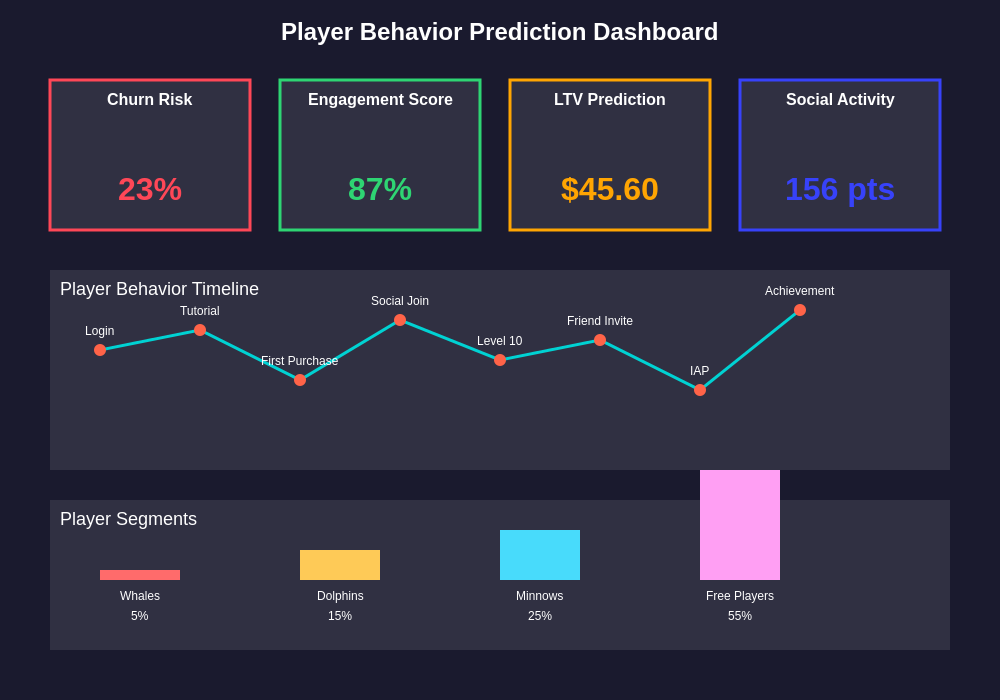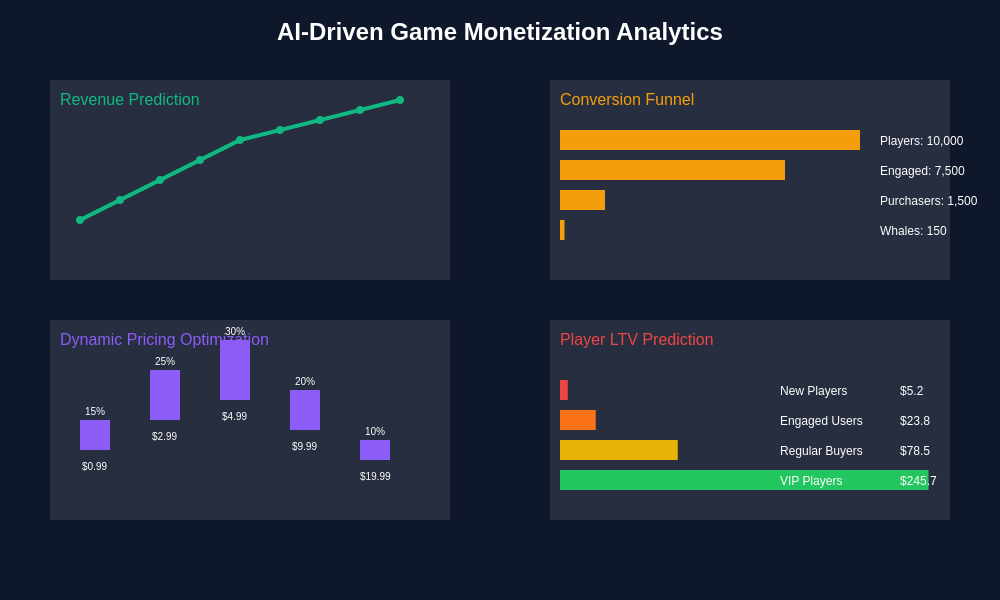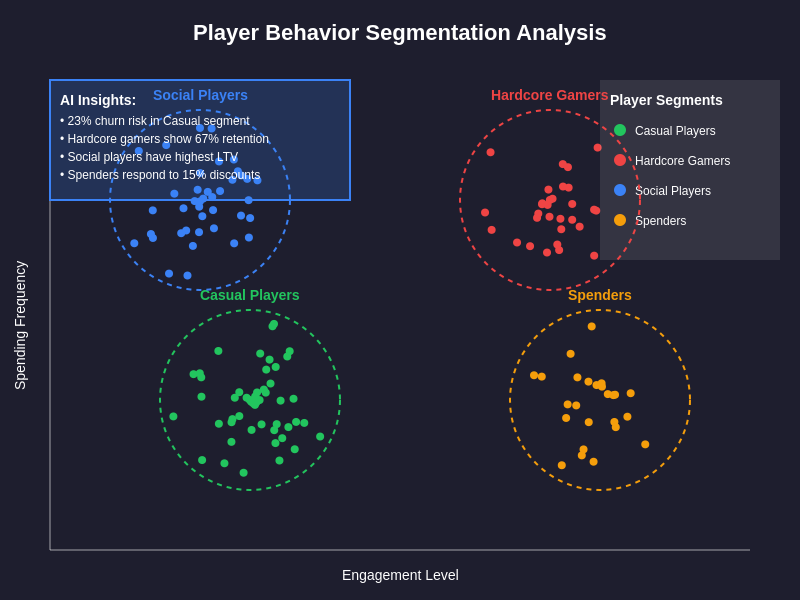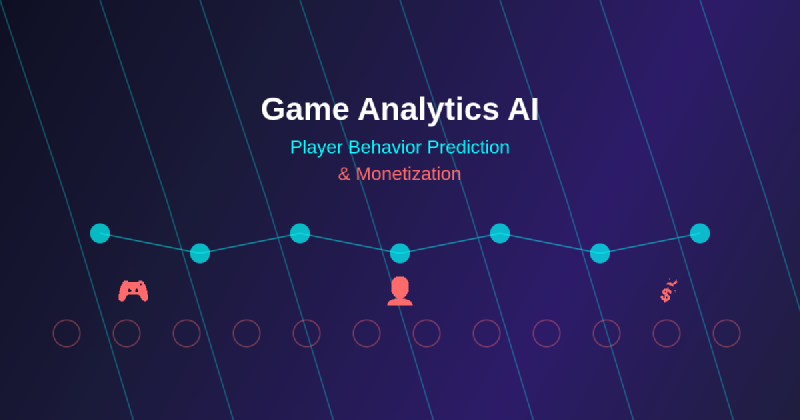The gaming industry has witnessed an unprecedented transformation through the integration of artificial intelligence into analytics platforms, fundamentally revolutionizing how developers understand, predict, and monetize player behavior. This technological evolution has created sophisticated systems capable of analyzing vast amounts of player data in real-time, enabling game developers to craft personalized experiences that maximize both player engagement and revenue generation through intelligent prediction algorithms and dynamic content optimization.
Explore the latest AI gaming trends to discover cutting-edge developments in player analytics and behavioral prediction technologies that are reshaping the interactive entertainment landscape. The convergence of machine learning, big data analytics, and real-time processing has created an ecosystem where every player interaction becomes a valuable data point for improving game design and monetization strategies.
The Evolution of Game Analytics Intelligence
Traditional game analytics relied heavily on basic metrics such as session duration, level completion rates, and simple demographic categorizations that provided limited insights into the complex psychological and behavioral patterns driving player engagement. Modern AI-powered analytics platforms have transcended these limitations by implementing sophisticated machine learning models that can process millions of data points simultaneously, identifying subtle patterns and correlations that human analysts might overlook entirely.
These advanced systems continuously monitor player interactions across multiple touchpoints, including gameplay mechanics, social interactions, in-game purchases, progression patterns, and even biometric responses where available. The integration of neural networks and deep learning algorithms enables these platforms to understand not just what players are doing, but why they are making specific choices and how their behavior is likely to evolve over time.
The predictive capabilities of modern game analytics AI extend far beyond simple trend identification, encompassing complex behavioral modeling that can forecast player lifetime value, churn probability, optimal pricing strategies, and personalized content recommendations with remarkable accuracy. This level of analytical sophistication has become essential for game developers operating in increasingly competitive markets where player retention and monetization efficiency directly impact business sustainability.
Advanced Player Behavior Prediction Models
The foundation of effective game analytics AI lies in sophisticated player behavior prediction models that leverage multiple data sources and analytical techniques to create comprehensive behavioral profiles for individual players and player segments. These models incorporate machine learning algorithms such as collaborative filtering, clustering analysis, and predictive modeling to identify patterns that correlate with specific player actions and preferences.
Modern prediction systems analyze gameplay patterns including movement trajectories, decision-making speed, risk tolerance levels, social interaction preferences, and spending behaviors to create multidimensional player profiles that evolve dynamically as new data becomes available. The integration of temporal analysis allows these systems to understand how player behavior changes over time, identifying critical moments where intervention strategies can be most effective for retention and monetization.
Enhance your AI projects with Claude to develop sophisticated analytics platforms that can process complex player behavior data and generate actionable insights for game optimization. The predictive accuracy of these models continues to improve through reinforcement learning techniques that adapt to changing player preferences and market dynamics.
Real-Time Behavioral Analysis and Intervention
The implementation of real-time behavioral analysis represents a significant advancement in game analytics AI, enabling developers to respond instantly to player behavior changes and implement dynamic interventions that can influence player decisions and engagement levels. These systems continuously monitor player actions and compare them against established behavioral patterns, triggering automated responses when specific conditions are met.
Real-time analysis capabilities include detection of player frustration through gameplay patterns, identification of potential churn indicators, recognition of optimal monetization moments, and prediction of social interaction opportunities that can enhance player engagement. The speed and accuracy of these real-time systems enable developers to implement personalized experiences that feel natural and responsive to individual player needs and preferences.
The integration of edge computing and cloud-based processing ensures that real-time analysis can be performed at scale without impacting game performance, allowing for seamless implementation of AI-driven features that enhance rather than detract from the gaming experience. These systems can automatically adjust difficulty levels, present targeted offers, suggest social connections, and modify content presentation based on predicted player preferences and behavioral patterns.
Personalization Through Predictive Modeling
Artificial intelligence has enabled unprecedented levels of personalization in gaming experiences through sophisticated predictive modeling that adapts game content, difficulty, and monetization strategies to individual player preferences and behavioral patterns. These personalization systems utilize machine learning algorithms to analyze player data and create customized experiences that maximize engagement and satisfaction while optimizing revenue generation opportunities.
The scope of AI-driven personalization extends across multiple game elements including dynamic difficulty adjustment, personalized content recommendations, targeted promotional offers, social matching algorithms, and adaptive user interface modifications. These systems continuously learn from player responses to personalized elements, refining their predictions and improving the accuracy of future personalization decisions.
Advanced personalization models incorporate psychological profiling techniques that identify player motivations, preferences, and engagement triggers, enabling developers to create experiences that resonate with individual players on a deeper level. The integration of behavioral economics principles into these models helps optimize the timing and presentation of monetization opportunities, increasing conversion rates while maintaining positive player experiences.
Monetization Optimization Through AI Analytics
The application of artificial intelligence to game monetization has revolutionized how developers approach revenue generation, moving beyond simple transaction tracking to sophisticated predictive models that optimize pricing strategies, promotional timing, and offer personalization. Modern AI monetization systems analyze player behavior patterns, spending histories, and engagement levels to identify optimal moments for presenting purchasing opportunities and determine the most effective pricing strategies for different player segments.
These intelligent monetization platforms utilize dynamic pricing algorithms that adjust offer prices based on predicted player willingness to pay, market conditions, and competitive factors. The integration of behavioral analysis enables these systems to identify players who are most likely to make purchases and customize offers to maximize conversion probability while maintaining fair and engaging experiences for all players.

The comprehensive nature of AI-driven monetization analytics enables developers to optimize their revenue streams through data-driven decision making rather than relying on intuition or limited testing. These systems can predict the long-term impact of monetization strategies on player retention and engagement, ensuring that revenue optimization efforts do not negatively impact the overall player experience or community health.
Churn Prediction and Retention Strategies
Player churn prediction represents one of the most critical applications of game analytics AI, enabling developers to identify players who are likely to stop playing and implement targeted retention strategies before churn occurs. Advanced machine learning models analyze multiple behavioral indicators including session frequency changes, engagement pattern shifts, social interaction decreases, and progression rate modifications to predict churn probability with high accuracy.
The sophistication of modern churn prediction models extends beyond simple behavioral tracking to incorporate psychological and motivational factors that influence player retention. These systems can identify subtle changes in player behavior that precede churn events, enabling proactive intervention strategies that address underlying issues before they lead to player departure.
Retention strategies powered by AI analytics include personalized re-engagement campaigns, targeted incentives, social reconnection opportunities, and gameplay modifications designed to address specific factors contributing to churn risk. The effectiveness of these retention strategies is continuously monitored and optimized through machine learning algorithms that adapt to changing player preferences and market conditions.
Leverage Perplexity AI for comprehensive research and analysis of player retention strategies and industry best practices that can inform your game analytics implementation. The integration of predictive churn models with automated retention systems has proven highly effective in maintaining player bases and extending player lifetime value.
Social Behavior Analysis and Community Optimization
The social dimensions of gaming have become increasingly important for player engagement and monetization, driving the development of sophisticated AI systems that analyze social interactions, community dynamics, and collaborative behaviors within gaming environments. These systems monitor communication patterns, team formation behaviors, mentorship relationships, and competitive interactions to understand how social factors influence player engagement and retention.
Advanced social behavior analysis enables developers to optimize matchmaking algorithms, facilitate meaningful social connections, identify potential community leaders, and detect toxic behaviors that could negatively impact the overall player experience. The integration of natural language processing and sentiment analysis allows these systems to understand the emotional context of player interactions and their impact on community health.
Community optimization through AI analytics includes automated moderation systems, social matching algorithms, guild formation assistance, and event recommendation engines that enhance social engagement opportunities. These systems continuously learn from successful social interactions and community outcomes, improving their ability to facilitate positive social experiences that strengthen player connections to the game and community.
Advanced Segmentation and Player Profiling
Modern game analytics AI employs sophisticated segmentation techniques that go beyond traditional demographic categorizations to create nuanced player profiles based on behavioral patterns, preferences, motivations, and engagement styles. These advanced segmentation systems utilize unsupervised machine learning algorithms to identify natural player clusters and create detailed profiles that inform personalized content delivery and monetization strategies.
The multidimensional nature of AI-driven player segmentation incorporates factors such as play style preferences, social interaction patterns, spending behaviors, progression rates, and content consumption habits. These comprehensive profiles enable developers to understand the diverse needs and preferences of their player base and create targeted experiences that resonate with different player types.
Dynamic segmentation capabilities allow player profiles to evolve over time as behaviors change and new data becomes available, ensuring that personalization strategies remain relevant and effective throughout the player lifecycle. The integration of predictive modeling with segmentation enables developers to anticipate how players might transition between segments and adapt their strategies accordingly.

The practical applications of advanced player segmentation extend across all aspects of game development and operations, from content creation priorities to marketing campaign targeting and customer support resource allocation. These sophisticated profiling systems enable developers to make data-driven decisions that optimize both player satisfaction and business outcomes.
Predictive Content Optimization
Artificial intelligence has transformed content optimization in gaming through predictive models that anticipate player preferences and optimize content delivery, difficulty progression, and feature introduction based on individual and segment-level behavioral patterns. These systems analyze how players interact with different types of content and predict which elements will be most engaging for specific player profiles.
Content optimization algorithms consider factors such as player skill progression, content consumption patterns, social preferences, and engagement history to create personalized content experiences that maintain optimal challenge levels and interest. The integration of A/B testing frameworks with predictive models enables continuous optimization of content strategies based on real player responses and outcomes.
The scope of predictive content optimization includes level design recommendations, feature prioritization, narrative branching decisions, and aesthetic customization options that align with predicted player preferences. These systems can also optimize the timing of content releases and updates to maximize player engagement and retention across different segments.
Revenue Forecasting and Business Intelligence
Game analytics AI has revolutionized revenue forecasting and business intelligence by providing accurate predictions of financial performance based on player behavior patterns, market trends, and seasonal factors. Advanced forecasting models incorporate multiple data sources including player spending patterns, engagement metrics, market competition analysis, and economic indicators to generate reliable revenue projections.
These sophisticated forecasting systems enable game developers to make informed decisions about resource allocation, development priorities, marketing investments, and strategic planning based on data-driven insights rather than intuition or limited historical data. The integration of machine learning algorithms continuously improves forecasting accuracy by learning from actual outcomes and adjusting prediction models accordingly.
Business intelligence applications powered by AI analytics include market opportunity identification, competitive analysis, player acquisition cost optimization, and lifetime value maximization strategies. These systems provide comprehensive dashboards and reporting tools that translate complex analytical insights into actionable business recommendations for stakeholders across the organization.
Fraud Detection and Security Analytics
The implementation of AI-powered fraud detection and security analytics has become essential for protecting game economies and maintaining fair play environments. Advanced machine learning models analyze player behavior patterns to identify suspicious activities such as cheating, account sharing, virtual currency manipulation, and bot usage that could compromise game integrity and player experiences.
These security systems utilize behavioral biometrics, statistical anomaly detection, and pattern recognition algorithms to distinguish between legitimate and fraudulent activities with high accuracy while minimizing false positives that could negatively impact honest players. The real-time nature of these detection systems enables immediate response to security threats and fraudulent activities.
The integration of fraud detection with other analytics systems provides comprehensive security coverage that protects both players and developers from various forms of abuse and exploitation. These systems continuously adapt to new fraud techniques and evolving threat landscapes through machine learning algorithms that improve detection capabilities over time.

The effectiveness of AI-powered security analytics extends beyond fraud detection to include protection of intellectual property, prevention of unauthorized access, and maintenance of competitive balance that ensures fair and enjoyable experiences for all players.
Future Developments in Game Analytics AI
The future of game analytics AI promises even more sophisticated capabilities including emotion recognition, biometric integration, virtual reality behavior analysis, and cross-platform player tracking that will provide unprecedented insights into player experiences and preferences. Emerging technologies such as quantum computing and advanced neural networks are expected to enable more complex modeling and real-time processing capabilities.
The integration of blockchain technology and decentralized analytics platforms may revolutionize data ownership and privacy considerations in game analytics while enabling new forms of player-controlled data monetization and personalization. The development of explainable AI systems will provide greater transparency into analytical decisions and recommendations, building trust between players and developers.
Advanced predictive capabilities may extend to market trend forecasting, competitive analysis, and strategic planning applications that help developers navigate increasingly complex and competitive gaming markets. The continued evolution of AI technology promises to unlock new opportunities for innovation in game design, player engagement, and business model optimization.
The ethical implications of advanced game analytics AI will require careful consideration of player privacy, data security, and fair play principles as these systems become more sophisticated and pervasive. Industry standards and regulatory frameworks are likely to evolve to address these concerns while preserving the benefits of AI-driven analytics for both players and developers.
Implementation Strategies and Best Practices
Successful implementation of game analytics AI requires careful planning, robust infrastructure, and comprehensive integration with existing game systems and development workflows. Organizations must invest in appropriate data collection mechanisms, storage solutions, processing capabilities, and analytical tools to support sophisticated AI-driven analytics platforms.
The development of internal expertise through training and hiring is essential for maximizing the benefits of game analytics AI, as these systems require ongoing optimization, maintenance, and strategic guidance to deliver optimal results. Collaboration between data scientists, game designers, business analysts, and engineering teams ensures that analytical insights translate into actionable improvements and innovations.
Privacy and security considerations must be integrated into the design and implementation of game analytics systems to protect player data and maintain compliance with regulatory requirements. Transparent communication with players about data collection and usage practices helps build trust and supports the ethical implementation of AI-powered analytics.
The iterative nature of AI system development requires continuous testing, validation, and refinement to ensure that analytical models remain accurate and relevant as games evolve and player behaviors change. Regular evaluation of system performance and business outcomes helps identify opportunities for improvement and optimization.
Disclaimer
This article is for informational purposes only and does not constitute professional advice regarding game development, analytics implementation, or business strategy. The information presented is based on current understanding of game analytics technologies and their applications. Readers should conduct thorough research and consider their specific requirements, regulatory obligations, and ethical considerations when implementing AI-powered analytics systems. The effectiveness and outcomes of game analytics AI may vary significantly depending on implementation quality, data availability, and market conditions.
